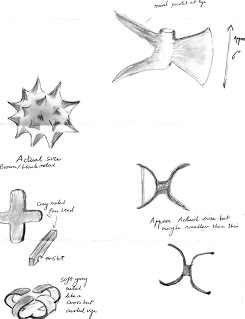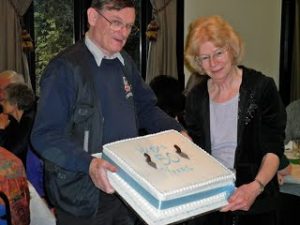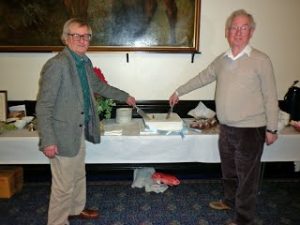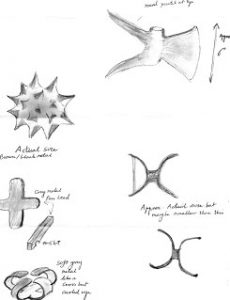
No.490 January 2012 Editor: Mary Rawitzer
HADAS DIARY
Lecture are held at Avenue House, 17 East End Road, Finchley, N3 3QE, and start promptly at 8 pm, with coffee/tea and biscuits afterwards. Non-members: £1. Buses 82, 125, 143, 326 & 460 pass nearby and Finchley Central station (Northern Line), is a short walk away.
Tuesday 10th January 2012 – The Merchant Taylors’ Great Feast, 1607. Lecture by Ann Saunders.
Dame Ann Saunders MBE FSA is a former HADAS President and a widely honoured historian and researcher on many aspects of London’s history. Her many publications include co-authorship of The History of the Merchant Taylors’ Company, covering 700 years of one of the “great twelve” livery companies.
Tuesday 21st February 2012 – The Medieval Cellars of Winchelsea. Lecture by Richard Comotto.
Tuesday 13th March 2012 – It’s all in the bones. Lecture by Jelena Bekvalac (Curator of Human
Osteology – Museum of London).
Tuesday 10th April 2012 – Conservation Techniques in Stone Masonry. Lecture by Stephen Critchley.
Tuesday 8th May 2012 – Bumps, Bombs and Birds: the history and archaeology of RSPB reserves.
Lecture by Robin Standring (RSPB Reserves Archaeologist).
Tuesday 12th June 2012 – Annual General Meeting.
Tuesday 9th October 2012 – The Life and Legacy of George Peabody. Lecture by Christine Wagg.
Tuesday 13th November 2012 – Tuesday 13th November 2012 – Archaeological Discoveries
in Southwark. Lecture by Peter Moore (Pre-Construct Archaeology)
Addendum to last month’s finds report from Hendon School Don Cooper
Following last month’s report on the finds from Hendon School (HDS06) in 2010 and 2011 (HADAS newsletter no. 489), I received back from the Museum of London seven sherds which had been given to them to identify and analyse. Their report identifies them as much-abraded Roman pottery sherds. They came from Trench A1, Context 2 of the 2011 excavation. Six are Oxford ware (OXID, dated AD50-400) and one is in a Brockley Hill fabric (BHWS, dated AD50–160). They are too abraded for their original forms to be identified. The Museum of London’s conclusion is that they are plough-soil scatter.
Inter alia I also received a very helpful e-mail from Pamela Taylor editor, of “A Place in Time”, the HADAS publication, which I failed to mention (mea culpa). Pamela points out that “Westminster Abbey obtained the whole of what became Hendon (an amalgamation of grants) during the mid-10th century and kept it pretty much intact up to the Reformation” rather than my suggestion of “ownership of the land by monasteries”. She also makes the point that Hendon was not part of the Danelaw, quoting in support the comment in The Place-Names of Hertfordshire (English Place-Name Society XV, 1932), page 26, that despite the name Dacorum, aka Daneis or Danish Hundred, which lies just north of Hendon, “The complete absence of any Danish place-name elements or personal names in the nomenclature of the Hundred shows that there can never have been any regular settlement here, even on a small scale”.
I am happy to accept both these comments.
Taylor, Pamela, ed. 1989, A Place in Time. London: Hendon and District Archaeological Society.
HADAS Anniversary – Mugs
At the recent HADAS party, attendees were given a ceramic mug suitably inscribed commemorating the HADAS 50th Anniversary. These mugs will now be available to all members at £3.50 each at the next HADAS lecture. So don’t forget to pick up your mug!!

Jim & Jo Nelhams, Hon. Treasurer & Secretary,
display 50th anniversary cake suitably decorated with trowels
Jim & Jo Nelhams, Hon. Treasurer & Secretary,
display 50th anniversary cake suitably decorated with trowels
Harvey Sheldon (President) & Don Cooper (Chairman) about to start digging in!!
Sunday Sunday Sunday Andrew Coulson (and others’ comments)
The highly enjoyable 50th Birthday Buffet on December 4th, superbly organized as ever, left one HADAS member with a lot of questions and an outbreak of (blank?) verse and then led your this month’s Editor down some obscure byways of HADAS’s history:
Sunday Sunday Sunday
Sundays come in various types. There are
remembrance days, memorial days, victory days and
days that live in infamy. Some of these days
are Sundays. Our day, Hadasday, was a Sunday.
Whether it was the right Sunday is open to
question. Whether it should have been a Sunday at all
is a still larger question. A one in three
hundred and sixty five chance of being right for the day; a
one in fifty two for Sundays. But can anyone
prove this? Possibly not. But at least we think we
have the year. The buff mugs in the Garden Room
commemorate the 25th year of the society and
are dated.
In 1961 a man of Hendon, Themistocles
Constantinides, founded an archaeological society to prove
or disprove the Saxon origins of Hendon. His
English is very good but what is a man with a name like
that doing in North London? A refugee perhaps or
perhaps the child of refugees. And why the interest
in North London. We don’t know. He must have had
a lot of personal weight because the society took
off and kept rolling. It still does.
And what’s this about the Saxon origins of Hendon?
The Oxford dictionary of English place names has two
entries, one dated 975 the other 1086. “Heandun”
and “Handone” meaning “the place at the high hill”. All he
had to do was look it up in the County Histories of
the day. But he didn’t: he wanted origins and to find those
he was going to have to dig in to a past 500 years
earlier. And to do that he was going to need an
archaeological society.
Hence us. But did he ever get what he wanted? We
do fine parties: last Sunday was a fine party. Lots of food,
carols extemporised by Mrs Baldwin, the Hon
Secretary on the washboards: a great time was had by all. But
what of our mission? Fifty years is surely enough
time to produce some results but we hear only silence. This
is more than mission creep, this is mission
stampede. Something must be done.
Reading this it became obvious that even some of our more long-standing members had never read – or had forgotten – the HADAS publication “A Place in Time”, edited by Pamela Taylor. This publicly confirmed the truth of Mr Constantinides’s hypothesis of the Saxon origins of Hendon and the value of the work done by HADAS, the organization which he (among others) founded, in showing this to be true. Sheer serendipity: Andrew was given a copy of the publication by a friend after writing his “Report” and while this Newsletter was still being prepared, and learnt much!.
But there is another question still: It’s difficult to find clear information about Mr Constantinides, his other interests, his work and world. I believe, but have failed to confirm it in the time available, that, rather than coming as refugees, his family was part of that mercantile Greek diaspora which traded very successfully in Mediterranean products, tobacco, dried fruit, etc., and settled in London in the late 19th/early 20th centuries. In our Newsletter archive there is almost nothing personal about him apart from John Enderby’s obituary of Ted Sammes (Newsletter 333, 1998) with a recollection of their enthusiastic days studying:
“I first met Ted in 1960 when, along with Brigid Grafton Green and Mr. Constantinides, he attended Professor Zeuner’ s archaeology lectures at the Hampstead Garden Suburb Institute. Ted quickly proved himself to be an outstanding student whose well-researched written work shamed the others. I immediately struck up a rapport with him and, as a comparative newcomer to the area, found him to be a fund of knowledge on Middlesex and Hendon in particular. It was Ted who persuaded Mr Constan (as he was always known) to found HADAS in 1961…”
Might the 50th anniversary be the right time for a project to gather facts and memories on and about our founder members?
Interesting conferences and courses for the New Year, and a refreshing walk too
– Thames Shipbuilding and Thames-built Ships Saturday 18th February 2012
The Docklands History Group is hosting its fifth Symposium, to be held at the Museum of London Docklands. The day promises to be a first rate event, which will appeal to a very wide range of interests. For more information see the Group’s website: www.docklandshistorygroup.org.uk
– The Long View: Place and Prehistory in the Thames Valley Saturday 25 February 2012
This one-day conference will be held at the Society of Antiquaries, Burlington House, Piccadilly. It concludes the conferences in the Prehistoric Society’s Thames Valley series with a look at the long-term histories of particular places or parts of the valley. It’s aim will be to explore the differing trajectories of settlement, land-use and ritual activity in different localities from the Mesolithic onwards, including the contrast between places which were intensively used during virtually every period, and those which were used more sporadically or less intensively at certain times. Price: £35 (£20 student), including coffee (lunch not provided, available locally).
– Study Days: The Writings of Ancient Egypt and Fighting Pharaohs: Warfare in Ancient Egypt
Joyce Filer BA, Dip. Arch, MSc (formerly Curator of Human & Animal Remains, Dept. Ancient Egypt & Sudan, British Museum, London) has organized two study days, on Saturday 18 February and Saturday 31 March 2012, both from11 am to 5 pm. The first course looks at the information obtainable form the writings of ancient Egypt. Joyce says the beautiful hieroglyphic inscriptions on tomb walls and the astonishing amount of papyrus documents discovered are justly famous, but perhaps less well-known is what these written sources cover: an absolutely amazing range of subjects from laundry lists and love poems to last wills and testaments.
The second study day will highlight Egypt’s approach to its many military campaigns. The ancient Egyptians left a huge amount of artistic, biological and textual sources giving information about their combatant activities: who they fought, why they fought and where these events took place. It will examine many aspects of military life in ancient Egypt, including weapons, tools & equipment, different types of military activity, war injuries & medical treatment, and the life of the ancient Egyptian soldier. A specially designed study display will give participants the opportunity to examine source materials and test their skills of analysis.
Both study days will be held at Hughes-Parry Hall (Garden Halls), 19-26 Cartwright Gardens, London, WC1H 9EF. Applications to Joyce Filer, Accountability, 4 Lowndes Court, London, W1F 7HE (cost £40 each), or more information from study.egypt@virginmedia.com
– Course: Life in Roman London Starting January 12th, Thursdays 10.30-12.30
Highgate Literary and Scientific Institution (HLSI) is running this course on Daily Life in Roman London, using archaeological evidence to examine the 350-year history of Roman London, tutored by John Shepherd. The Spring term starts on January 12th 2012.
Few people lived in the area of the modern city before the Romans arrived and the earliest Roman town was probably more like a frontier town, but the consequences of the Boudiccan revolt in AD60-61 were to change all this. From that date onwards the Roman city of London began to flourish. This course will examine London’s buildings and people, how it was organised and the crafts and trades that were carried out. London’s fortunes changed over the centuries and the course will chart its course to the fifth century and its abandonment. For more information: phone 020 8340 7434 or e-mail admin@hlsi.net (website: www.hlsi.net).
– “An exploration of Sulloniacis: Hendon Central to Stanmore” Walk, 28th January 2012
Jane Rosoux, a well-known walks organiser is leading this Hampstead Ramblers walk. Starting at Hendon Central Station at 09.30 prompt, it is an 18.1 mile walk finishing at Stanmore Station.
A good description of the walk and its relationship to our area’s Roman period can be found at http://www.hampsteadramblers.org.uk/self-guided-walks/10-other-self-guided-walks/28-romano-british-estate-of-sulloniacis.html. It should perhaps be pointed out that the historical part of this description covers a period of which very many aspects remain obscure – in both framework and detail – and perhaps it presents a rather more concrete picture than picking up on the many uncertainties would have done!
Contact Hampstead Ramblers for more details at http://www.hampsteadramblers.org.uk/contacts.html The walk is described as strenuous!!
The Thames Discovery Programme November 8th Lecture Natalie Cohen
By Jo Nelhams
Without the River Thames there would be no London as water is the vital ingredient for human settlement. The Thames rises in the Cotswold Hills at Thames Head – a dispute over the source of the River, between Thames Head and Seven Springs, was decided by Act of Parliament in 1937 and Thames Head won. The river then flows through a variety of water meadows, farmland, cuts a deep gap through chalkland at Goring, through various historic places and towns, before flowing out through the Thames estuary to the North Sea.
Many changes, especially through human activity, have modelled the Thames to how we perceive it today. The Victorian Embankment designed by the great engineer Sir Joseph Bazalgette to improve the disposal of waste through sewers, has restricted the width, as has the construction of the docks. This narrowing has increased the flow, which in turn has led to accelerated erosion.
The Thames is an extensive resource for river studies and the Thames Explorer Trust has encouraged schools for many years to come to the river for various forms of study. Instigated in 2008, the Thames Discovery Programme was launched in October of that year. It involved training many volunteers to form the Foreshore Recording and Observation Groups or FROGS. The foreshore was walked from Richmond to Greenwich by a group of professional archaeologists. The Thames foreshore is the longest archaeological site in London. Twenty survey zones were selected, based on various criteria such as quality of features exposed, severity of erosion, accessibility and geographical location. These twenty survey zones will be only a sample for long term study as it is not possible to monitor the whole of the foreshore. Information concerning these sites can be found on the Thames Discovery website:
(www.thamesdiscovery.org/riverpedia/key‑sites-index).
Between 2008 and 2011 many features not previously recorded have emerged and been recorded. These include: London’s earliest prehistoric structure which is a Mesolithic site at Vauxhall
A number of Saxon fishtraps showing different types of fish trap construction
A jetty structure at Greenwich possibly medieval
Fragments of vessels including part identified as HMS Wellington(1852) at Charlton
The launch site of Brunel’s SS Great Eastern at Millwall.
It is important to record and photograph these discoveries, as features and structures are being eroded and some have been lost and are no longer evident. The vital monitoring work of the Thames Discovery Programme has shown that some features are still partially visible, but others now only survive in paper records and photographs.
The Thames Discovery Programme was funded by a grant from the Heritage Lottery Fund, which ceased at the end of September 2011, but the good news is that the work will continue as a core team have new contracts with MoLA (Museum of London Archaeology). The vital work of the FROG volunteers will need to continue as well. The work and discoveries so far have revealed a fascinating insight into activities along the River Thames in days gone by. This has shown how human occupation has used the Thames over centuries to aid its survival. The Thames indeed holds many stories and maybe secrets, and is still a great source for enhancing our knowledge today.
Our thanks go to Natalie Cohen for a very informative and entertaining lecture and we shall look forward to hearing of future developments from the Thames Discovery Programme.
Isle of Wight (Wednesday, Day 2 – part of part 2) Jim Nelhams
Wednesday was always going to be our riskiest day. Two boat crossings of the Solent in a small ferryboat. Hurst Castle with little shelter and, on our return to the island, an open-top bus trip to the Needles Batteries. The only other way to get to the batteries is a mile long walk from Alum Bay. And when we awoke, it was raining.
The Needles is not the flattest part of the island, but the bus trip was a circular route, with commentary.
The choices this allowed meant that while most people opted to visit the batteries, some stayed in Yarmouth, some stayed on the bus for the whole round trip back to Yarmouth, while Ken Carter and Micky Watkins stopped at Dimbola Lodge. Where? Ken’s report will explain that.
Fortunately everybody made it back to Yarmouth to find our Galleon.
Dimbola Lodge Ken Carter
Where did the life paths of these people cross – Julia Margaret Cameron, Jimi Hendrix and Virginia Woolf? It’s like a question on ‘Round Britain Quiz’.
Julia Margaret Cameron lived in Dimbola Lodge, Freshwater Bay, Isle of.Wight, from 1860 to 1875. For her 48th birthday in 1863 her daughter gave her a large plate camera. She hoped the gift would give her mother a new interest while Mr. Cameron (aged 68) was overseas, attending to business affairs in Ceylon. The present was a spectacular success. Briskly, her mother descended on an old chicken hut in the garden and turned it into a studio. She started photographing anyone she could persuade to sit for her – local children, friends’ children, neighbouring fishermen (Dimbola Lodge had originally been a cluster of fishermen’s cottages), her near neighbour & friend Lord Tennyson and distinguished visitors such as Robert Browning, Charles Darwin, G. F. Watts and his young wife, Ellen Terry. Since Julia Margaret Cameron claimed copyright for each of her photos, we have a record of the thousand or so she took during just 12 years of strenuous, excited activity. These photos are deliberate works of art. She chose individual, revealing backdrops for her sitters; she excelled in catching character-indicating aspects; she ruffled children’s hair so that they didn’t have the glazed expressions of stuffed dummies; she created many a naturalistic, posed illustration (such as for ‘Idylls of the King’). She aimed for a poetic realism. I was amazed at the life and blood freshness of her photo of Robert Browning – ready to answer me had I spoken to him. What a record, then! – a remarkable photographer … an ‘amateur’, in the finest sense … a Victorian woman of great distinction.
The statue of Jimi Hendrix stands in the front garden of Dimbola Lodge – almost 2/3 life-size, blackish against the light green lawn. He played his last concert just down the road, in 1970. Some 600,000 were at the festival, larger than the number at Woodstock that year. 19 days later, Jimi Hendrix was dead. Dimbola Lodge hosts memorabilia of the early festivals, holds exhibitions connected with rock and rock stars, together with posters & images of the I.o.W. Festivals since 2002.
Virginia Woolf was a great niece of Julia Margaret Cameron. Her sole surviving play, ‘Freshwater’, written for her friends, figures her great aunt and her associates cavorting in Dimbola Lodge. It is occasionally revived. One such – two decades ago – was at Offstage, Chalk Farm, in which the part of Ellen Terry was ‘deliciously taken’ by one Sarah Carter, my daughter.
Were these from the Battle of Barnet? By Don Cooper
David Dunk was at school at Cromer Road in the late 1950s. He and his family were living at 5 East Barnet Road. His father unearthed the items below in their back garden together with a lot of animal bones, his father thought were horse bones. David took the items into school to show them, but unfortunately they then went missing (it is possible somebody may have them, it would be great if they turned up – contact me at the address below.). Here is a drawing made by David (excellent! if I may say so) for me so that I could publish them. I look forward to receiving HADAS member’s views.
News of other events by Eric Morgan
Thursday 5th January 8pm: Pinner Local History Society, Village Hall, Chapel Lane Car Park, Pinner. Talk by Terry Jenkins: “Sir Ernest Lemon: The Railwayman who equipped the RAF for war”. Visitors £2.
Monday 9th January 3pm: Barnet & District Local History Society, Church House, Wood St, Barnet. Talk by Pamela Wright: “The Life and Times of Octavia Hill
Wednesday, 11th January 2.30-4pm: Mill Hill Historical Society, Wilberforce Centre, St Paul’s Church, The Ridgeway, NW7 1QU. Talk by Wing-Commander Erica Ferguson: “The History of Bentley Priory: WW2 Bomber Command.
Wednesday 11th January 7.45pm: Hornsey Historical Society, Union Church Hall, corner Ferme Park Rd/Weston Park. Talk by Janet Owen: “Images from the North Middlesex Photographic Society” Visitors £2. Refreshments, sales & info.
Saturday 14th January 2-4pm: Museum of London, London Wall, EC2Y 5HN. Walk “Walking the Roman Wall”. Book in advance, £10 (concs £8) 020 7001 9844 or thro’ www.museumoflondon.org .
Tuesday, 17th January 6.30pm: LAMAS, Clore Learning Centre, Museum of London, London Wall, EC2Y 5HN. Talk by Julian Hill (MoLA) ” Mapping Roman London: from site context to town plan”. Refreshments 6pm. Please note this lecture is on Tuesday, not Thursday as in December’s Newsletter
Wednesday, 18th January .7.45pm: Edmonton Hundred Historical Society, Jubilee Hall, 2 Parsonage Lane/junction Chase Side, Enfield. Talk by Graham Dalling “Architectural Photography”. Visitors £1
Thursday, 19th January 8pm: Enfield Society, Jubilee Hall, as above. Talk by Dave Cockle “The History of Enfield’s Railways, Part 1. Lea Valley, Southbury Loop, Enfield Town”.
Friday, 20th January 7pm: COLAS, St Olave’s Parish Hall, Mark Lane, EC3. “Talk by Lyn Blackmore (MoLA) “Londinium to Lundenwic: Saxon London & its Region” £2.
Tuesday, 24th January 6pm: Gresham College at Museum of London, as above: Talk by Richard J Evans “Empire: from Conquest to Control”. Free.
Thursday, 26th January 6pm: Gresham College, Barnard’s Inn Hall, Holborn, EC1N 2HH: Talk by Dr Patrick Wallis & Dr Christopher Minns (LSE) “Apprenticeship in Early Modern London: Economic origins & destinations of apprentices in 16th & 17th centuries. Free.



